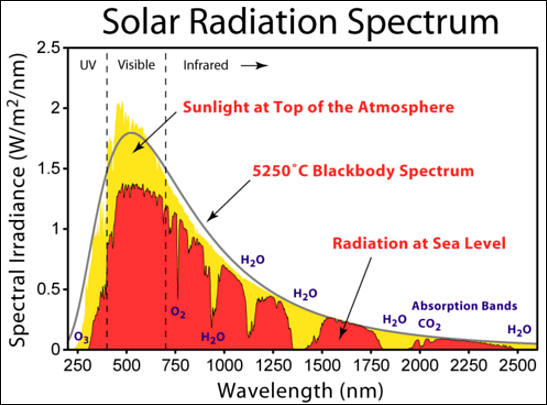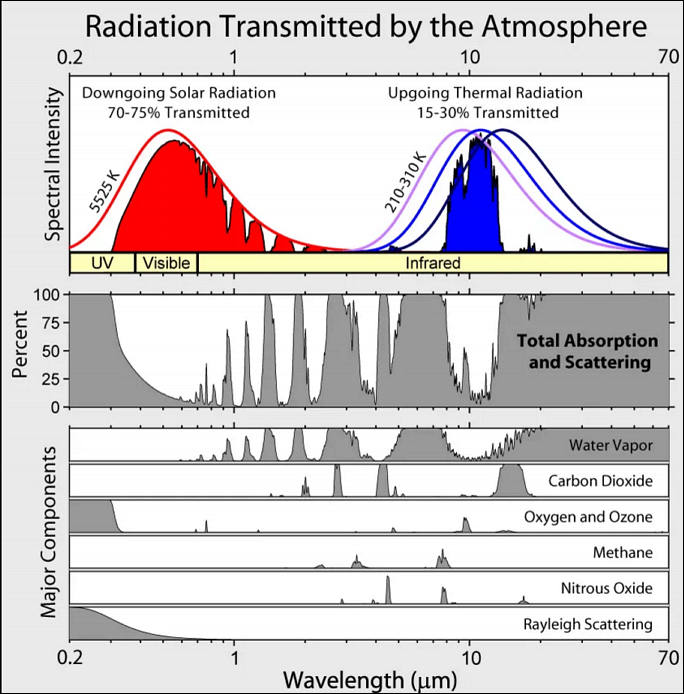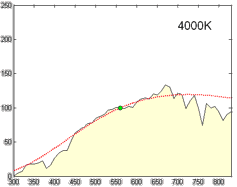
-
If you read any color quality metrics standard you will see interesting part most treat as not very important.
At certain color temperature they switch (instantly or smooth, not so important) one standard illuminant (black body, or tungsten lamp spectrum) to another - sun spectrum (during middle of non cloudy day and at sea level, actually it is math approximation).
Almost all difference actually is only black body (radiating thing) temperature and atmosphere filtering effects.


-
It's a very interesting topic because many people assume that the solar spectrum is very even across all wavelengths. This is reasonably accurate in the vacuum of space but the earth's atmosphere will absorb certain wavelengths based on it's chemical composition and density or thickness. We see the effect of this as colour temperature shifts (morning, midday & sunset for an example of the atmosphere thickness affecting wavelength absorption) but there is more subtle effect where certain wavelengths are reduced by the elements in the atmosphere absorbing the sun's radiation in selective bands in different amounts depending upon the atmosphere's thickness, (as illustrated by Vitaliy) resulting in certain colours being mis-represented when compared to a midday sun, even after being colour corrected.
Colour spectrum research on artificial light sources is very interesting for film makers as it can reveal the reasons why certain light sources (sodium street lamps for example) are more difficult to correct than others.
Howdy, Stranger!
It looks like you're new here. If you want to get involved, click one of these buttons!
Categories
- Topics List23,979
- Blog5,724
- General and News1,353
- Hacks and Patches1,153
- ↳ Top Settings33
- ↳ Beginners255
- ↳ Archives402
- ↳ Hacks News and Development56
- Cameras2,362
- ↳ Panasonic991
- ↳ Canon118
- ↳ Sony156
- ↳ Nikon96
- ↳ Pentax and Samsung70
- ↳ Olympus and Fujifilm100
- ↳ Compacts and Camcorders300
- ↳ Smartphones for video97
- ↳ Pro Video Cameras191
- ↳ BlackMagic and other raw cameras116
- Skill1,961
- ↳ Business and distribution66
- ↳ Preparation, scripts and legal38
- ↳ Art149
- ↳ Import, Convert, Exporting291
- ↳ Editors191
- ↳ Effects and stunts115
- ↳ Color grading197
- ↳ Sound and Music280
- ↳ Lighting96
- ↳ Software and storage tips267
- Gear5,414
- ↳ Filters, Adapters, Matte boxes344
- ↳ Lenses1,579
- ↳ Follow focus and gears93
- ↳ Sound498
- ↳ Lighting gear314
- ↳ Camera movement230
- ↳ Gimbals and copters302
- ↳ Rigs and related stuff272
- ↳ Power solutions83
- ↳ Monitors and viewfinders339
- ↳ Tripods and fluid heads139
- ↳ Storage286
- ↳ Computers and studio gear560
- ↳ VR and 3D248
- Showcase1,859
- Marketplace2,834
- Offtopic1,319




